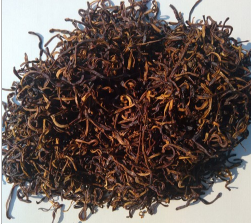An earthworm is a tube-shaped, segmented worm found in the phylum Annelida. Earthworms are commonly found living in soil, feeding on live and dead organic matter. An earthworm's digestive system runs through the length of its body. It conducts respiration through its skin. It has a double transport system composed of coelomic fluid that moves within the fluid-filled coelom and a simple, closed blood circulatory system. It has a central and a peripheral nervous system. The central nervous system consists of two ganglia above the mouth, one on either side, connected to a nerve cord running back along its length to motor neurons and sensory cells in each segment. Large numbers of chemoreceptors are concentrated near its mouth. Circumferential and longitudinal muscles on the periphery of each segment enable the worm to move. Similar sets of muscles line the gut, and their actions move the digesting food toward the worm's anus.
Earthworm populations depend on both physical and chemical properties of the soil, such as temperature, moisture, pH, salts, aeration, and texture, as well as available food, and the ability of the species to reproduce and disperse. One of the most important environmental factors is pH, but earthworms vary in their preferences. Most favor neutral to slightly acidic soils. Lumbricus terrestris is still present in a pH of 5.4 and Dendrobaena octaedra at a pH of 4.3 and some Megascolecidae are present in extremely acidic humic soils. Soil pH may also influence the numbers of worms that go into diapause. The more acidic the soil, the sooner worms go into diapause and the longer they remain in diapause at a pH of 6.4.
Earthworms form the base of many food chains. They are preyed upon by many species of birds (e.g. starlings, thrushes, gulls, crows, European robins and American robins), snakes, mammals (e.g. bears, foxes, hedgehogs, pigs, moles) and invertebrates (e.g. ground beetles and other beetles, snails, slugs). Earthworms have many internal parasites, including protozoa, platyhelminthes, and nematodes; they can be found in the worms' blood, seminal vesicles, coelom, or intestine, or in their cocoons.
Nitrogenous fertilizers tend to create acidic conditions, which are fatal to the worms, and dead specimens are often found on the surface following the application of substances such as DDT, lime sulphur, and lead arsenate. In Australia, changes in farming practices such as the application of superphosphates on pastures and a switch from pastoral farming to arable farming had a devastating effect on populations of the giant Gippsland earthworm, leading to their classification as a protected species.
The addition of organic matter, preferably as a surface mulch, on a regular basis will provide earthworms with their food and nutrient requirements, and will create the optimum conditions of temperature and moisture that will stimulate their activity.
The processing of Freeze dried earthworm is clean and soak the earthworm, and then put into the low-temperature (-30℃) vacuum freeze drying box, after 39 hours to obtain the swelled dry earthworm. Moisture of freeze dried earthworm is within 5% which not only the pretty good pet feed but also can be useing in the file of medicine, health products, cosmetics and etc.
